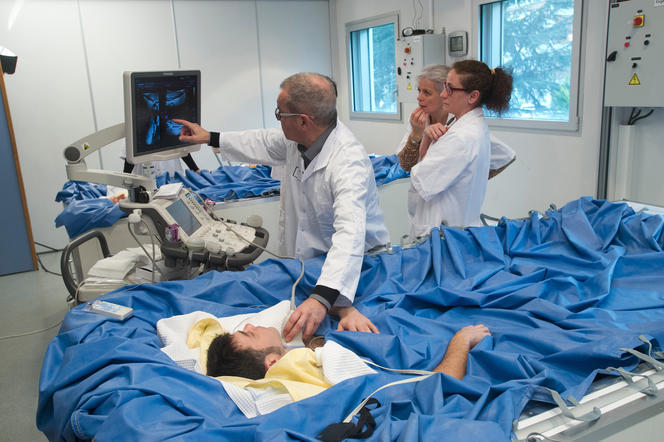You are here
A Sedentary Lifestyle is the Sworn Enemy of our Health

Scientific studies funded by space agencies can have unexpected repercussions on the daily lives of simple earth-dwellers. That is the case of studies performed on the effects of physical inactivity and sedentariness, which have thrown new light on the condition of men and women who are (too often) sitting down. Spending hours every day without moving, in front of a computer or television, does not just cause back pain, far from it. Sedentariness literally disrupts our metabolism, as Audrey Bergouignan, a physiologist at the IPHC,1 has observed.
“I focus on both the effects of physical inactivity – which means not practising a sport – and sedentariness, which is spending too much time sitting down,” explains the biologist, who uses two types of model for her studies. The “bedrest” model derives directly from space science and consists in recreating the effects of microgravity on Earth. “In practice, we ask healthy volunteers to lie down all the time for periods ranging from three weeks to as much as three months.” The researcher also uses the “dry immersion” model which is deployed for much shorter periods of three to five days because it is so uncomfortable: the subjects are immersed to the neck in thermoneutral water, covered with an elastic waterproof fabric. They are freely suspended in the water mass, thus having the sensation of a complete lack of support.
These large-budget international studies, some of which are carried out at the Clinique de l’Espace in Toulouse (southwestern France), focus on the consequences of sedentariness on all health parameters: muscle mass, bone density, hormones, psychology, circadian rhythms and nutrition and metabolism, which is Audrey Bergouignan’s speciality.
Results are unequivocal. “In slim and healthy individuals, after just a few days metabolic disturbances occur that are identical to those seen in diabetic or obese people, particularly concerning the use of lipids and carbohydrates by the body.” The first observation in these subjects under prolonged bedrest is hyperlipidaemia – high fat levels in the blood – associated with the metabolism’s inability to burn the lipids in question. “When you become inactive, the body starts to prefer using carbohydrates to produce the energy it needs, tending to burn fewer lipids, which will therefore accumulate in the adipose tissues, as well as in tissues where they should not be found, such as the muscles, bones, liver or even pancreas.”
Another worrying consequence of sedentariness is the development of resistance to the effects of insulin, the hormone that signals to the body to use carbohydrates circulating in the blood. “This insulin resistance, which precedes pre-diabetes and type 2 diabetes (non-genetic) is seen after just three days!” indicates the scientist, who is nevertheless reassuring: when the cessation of physical activity only lasts a few weeks, both hyperlipidaemia and the reduction in the body’s sensitivity to insulin are reversible.
“These are of course extreme experiments,” she points out. “Except in unusual situations, one generally does not spend all day in bed. Nevertheless, studies conducted in conditions of sedentariness similar to those that many of us experience have confirmed these metabolic disturbances and the speed with which they develop.”

To demonstrate this, the research team asked physically active and healthy people to stop exercising for a month and change their behaviours by using lifts more often – or the car for short trips. They also asked those who walked 12,000 steps a day to reduce their activity to 2000 steps. “After ten days, we could see that the harmful effects of immobility had been triggered – a change to lipid utilisation, reduced sensitivity to insulin – and a very strong correlation between the level of inactivity and these two parameters,” explains Bergouignan, who for several years has been testing strategies to counteract the effects of sedentariness in both astronauts and men and women in the street.
“We tested two types of physical activity during our space studies,” she explains. These were “resistive” activities that do not increase cardiac and respiratory capacities (such as push-ups or weightlifting) and “aerobic” exercises such as running or cycling, which accelerate the heart rate and boost respiratory function.” Although deploying them during space missions can to some extent contribute to combatting muscle atrophy (notably in the case of resistive movements), neither of them was sufficient to offset all the negative metabolic effects, and in particular the incorrect use of fats.
“This astronaut paradigm, where missions are both extremely sedentary and extremely athletic, is the same as that of office workers who spend days at their desks and go running at the weekend,” explains the scientist, who is surprised at the lack of health messages on the impact of a sedentary lifestyle, which is nonetheless the fourth leading cause of death worldwide. “An additional hour spent sitting down each day increases the risk of becoming diabetic by 22% and that of being obese by 30%.”
Occasional physical activity is not enough to compensate for the adverse effects of sedentariness: “if all metabolic parameters are to improve, then it is necessary to both increase physical activity and reduce the time spent sitting down,” explains the scientist, who is trying to identify the most effective countermeasures to improve our health.
She thus asked overweight, sedentary individuals to complete 45 minutes of rapid walking every day for a month “either at once, or once an hour for five minutes,” she explains. The first observation, and not the least, was that under both regimes, the subjects said that they felt less tired, were in a better mood and less hungry during the day. Metabolic parameters improved all round, with an advantage in favour of physical activity spread out over short periods during the day – which came as a surprise as it is contrary to common belief! “At a metabolic level, after a month, and in both groups, we noted an equivalent rise in energy expenditure and a higher capacity to utilise lipids.” As for the body’s ability to control blood sugar levels, although it improved in both cohorts, it was clearly better in the individuals who had spread their physical activity over the day.
“This is good news for those who do not practise sports and an important message that should be widely circulated in the current context of lockdown,” confirms the physiologist. In other words, not exercising for a few weeks is no cause for concern, because moving a little throughout the day can lessen the harmful effects of sedentariness – getting up from the sofa and doing some housework, walking up and down stairs wherever possible, etc. “If sitting down for an additional hour increases the risk of becoming diabetic by 30%, reducing that time by an hour can conversely lower this risk by 30%. It’s all in our hands!
- 1. Institut Pluridisciplinaire Hubert Curien (CNRS / Université de Strasbourg).

















